A plant like chrysalidocarpus (Chrysalidocarpus) is directly related to the Arecaceae family. This palm tree is quite common and in nature it can be found in Madagascar and the Comoros. The genus was so named because of the light yellow color of the fruit. From the ancient Greek language chryseus - "golden", karpos - "fruit". It happens that such palms are called areca (outdated name).
Such a palm tree can be both multi-stemmed bushy and single-stemmed. It can reach a height of 9 meters. Erect non-branching stems have a pubescent or smooth surface. There are shoots swollen in rings, they may also have lateral offshoots, which together represent a group. The cirrus leaves have 40 to 60 pairs of lanceolate leaves that are dissected at the tops. The leaves are located in the upper part of the shoots on thin cuttings. There are species in which basal leaves grow near the stem and they merge with the general crown of the plant. This plant is both bi and monoecious.
Chrysalidocarpus care at home
Illumination
This plant loves bright light and is calm in direct sunlight. Recommended to be placed near a south-facing window. However, in the summertime, the palm will need to be shaded from the scorching midday sun rays.
Temperature regime
In summer, chrysalidocarpus needs warmth from 22 to 25 degrees. At other times, it needs to be rearranged in a place with a temperature of 18 to 23 degrees (but not less than 16 degrees). Throughout the year, the plant needs regular ventilation of the room, but at the same time remember that the palm tree must be protected from the effects of drafts.
Humidity
Needs high humidity. In this regard, in the spring and summer period, it needs to be sprayed regularly and often enough. To do this, use well-settled soft water at room temperature. You also need to wash the leaves of the plant once every 2 weeks. In the autumn-winter period, it is impossible to moisten the palm tree from the sprayer.
How to water
In spring and summer, watering should be plentiful and is carried out as the topsoil dries up. To do this, use well-settled soft water. With the onset of the autumn period, they begin to gradually reduce watering, bringing it to moderate. When doing this, make sure that the soil in the pot does not dry out completely.In the autumn-winter period, overflow is unacceptable, because it can extremely negatively affect the state of the chrysalidocarpus. At this time, watering is recommended after 2 or 3 days have passed after the topsoil has dried.
Top dressing
Fertilize the plant throughout the year. In the spring-summer period, feeding is carried out 1 time in 2 weeks. To do this, use fertilizer for palm trees or mineral fertilizer for decorative deciduous plants. In the cold season, fertilizers should be applied to the soil 1 time in 4 weeks.
Earth mix
To prepare a suitable soil mixture, it is necessary to combine humus-leaf, light clay-sod and peat soil, as well as rotted manure and sand, which should be taken in a ratio of 2: 2: 1: 1: 1. You also need to add a small amount of charcoal to the mixture. If desired, you can purchase ready-made potting soil for palm trees.
Transplant features
Reacts extremely negatively to the transplant. In this regard, experts recommend transshipment, while it is necessary to replace the drainage and fill up with fresh soil mixture. Young plants are subjected to this procedure once a year, older plants - once every 3 or 4 years. Large specimens should not be reloaded; instead, the top layer of the substrate should be replaced once a year. Do not forget about good drainage at the bottom of the container.
Reproduction methods
You can propagate by root suckers or seeds. Before sowing in a light peat substrate, the seeds should be soaked in lukewarm water (30 degrees) for 2–4 days. The container is placed in a well-lit, warm (20-25 degrees) place with high humidity. The first seedlings will appear 3-4 months after sowing. After the appearance of the first true leaf, the plant must be transplanted into a separate pot with a diameter equal to 10-12 centimeters.
Root offspring grow from the inferior adventitious buds. At the base of the offspring, their own root system develops. Such offspring can be easily separated from the mother plant and rooted in light soil. It is recommended to propagate in this way in the spring and summer.
Pests and diseases
Can catch a fungal infection. As a result, spots form on the foliage, which gradually grow. They have the shape of an oval or a circle, and are painted brown-red with a pale outline. In order to cure a palm tree, it must be treated with a fungicide and for a while stop moisturizing the foliage.
Worms often settle on the bottom of the leaves. As a result, the leaf begins to turn yellow and is damaged. It is recommended to wipe the leaves with a cotton swab moistened with alcohol, and treat the plant with an insecticidal preparation.
Due to the settled mites, light yellow specks appear and the leaves gradually dry out. Treatment with acaricide should be carried out, as well as more frequent moistening of the foliage from the sprayer.
Possible difficulties
- The tips of the leaves are brown - low air humidity, poor watering, low air temperature, foliage damage as a result of touching its surface.
- On foliage brownish spots - overflow, a sharp drop in temperature, or hard water is used for irrigation.
- The tips of the foliage turn brown - low air humidity, too cold, poor watering.
- Leaves turn yellow - too intense lighting, poor watering.
- The foliage turns brown - over time, the lower leaves darken and fall off. They cannot be cut off, but only cut off. The darkening of the entire palm tree and the presence of signs of decay indicates overflow.
Main types
Chrysalidocarpus yellowish (Chrysalidocarpus lutescens)
This plant is bushy, and it branches rather strongly at the base and has rooting side stems. Leaf petioles and young trunks are light yellow with small dark black dots. Their surface is comparatively smooth. Arcuate leaves can be up to 200 centimeters long, and their width is 80–90 centimeters.Each leaf consists of 40–60 pairs of not drooping sufficiently strong leaves, reaching 15 millimeters in width. The furrowed petiole can reach a length of 50-60 centimeters. It is colored yellow and has a layer of blackish small scales on its surface. The axillary inflorescence is highly branched. This dioecious tree prefers to grow in a warm room.
Chrysalidocarpus madagascariensis (Chrysalidocarpus madagascariensis)
Such a plant is single-stemmed and it can reach a height of 9 meters, while the trunk diameter is 20-25 centimeters. The smooth trunk is slightly widened at the base and rings are clearly visible on it. Cirrus leaves consist of shiny leaves, arranged in a bundle and reaching a length of 45 centimeters. The axillary highly branched inflorescence has a length of 50 to 60 centimeters. The palm tree is grown only in a warm room.

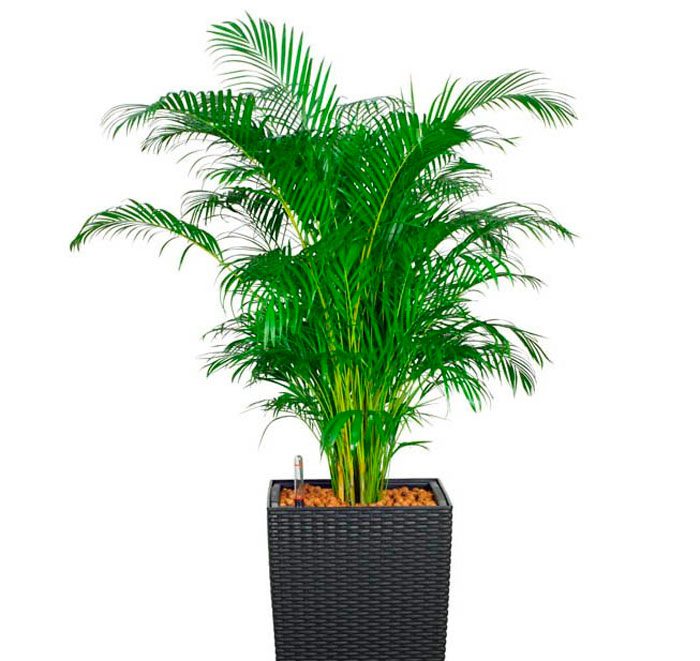
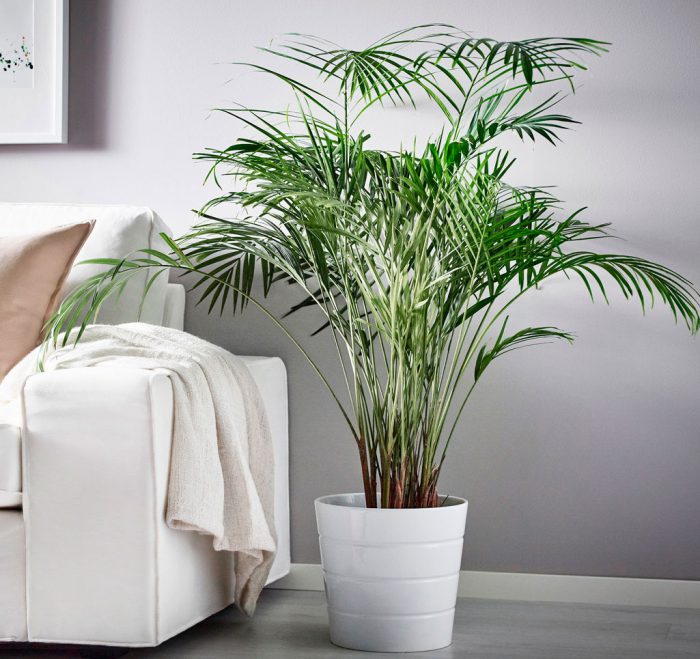
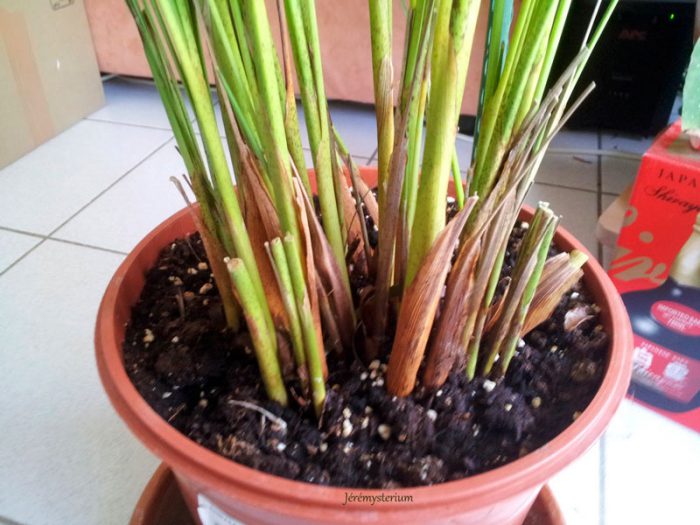
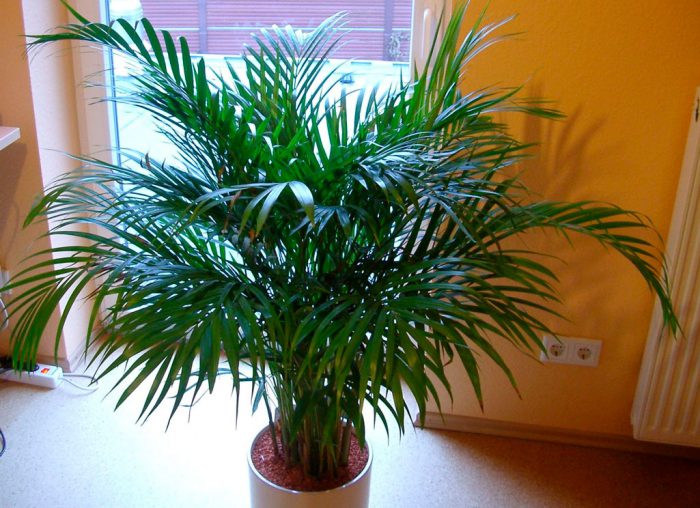
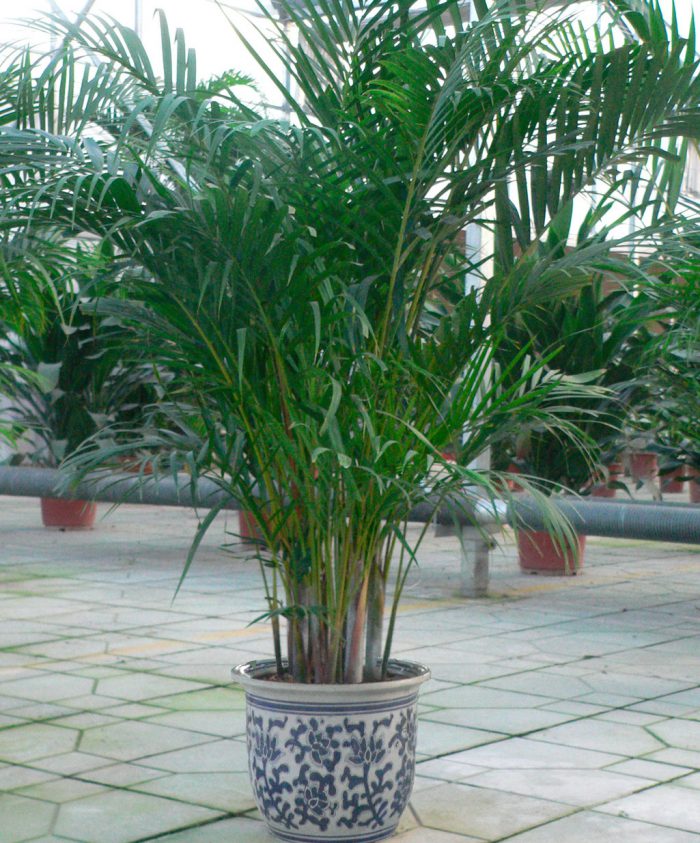


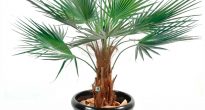


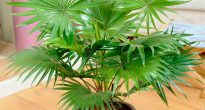

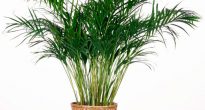

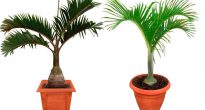

Please tell me how to save a young chrysolidocarpus,
It did not turn yellow, not black, did not change color in any way, it simply began to fall asleep like a herbarium only at the root.
I do not know what to do, and I watered and sprayed. This is a cry from the heart, please tell me.
Lina, I had the same problem with chamedorea and also in the autumn-winter months. Some of the stems shriveled green like a herbarium. Some of the tables were lost. This continued until I adjusted the watering. Watering has become less so that the soil does not dry out on the surface of the pot, but at the same time spray it 1-2 times a day. Sometimes I add succinic acid to the water for spraying, sometimes a drop of honey, sometimes HB-101 fertilizer. Inoda (very rarely, once every 1-2 months) I wipe each leaf with soapy water from dust and as a prophylaxis against spider mites. Has ceased to dry out.
Deathly afraid of direct rays of light. Verified many times.